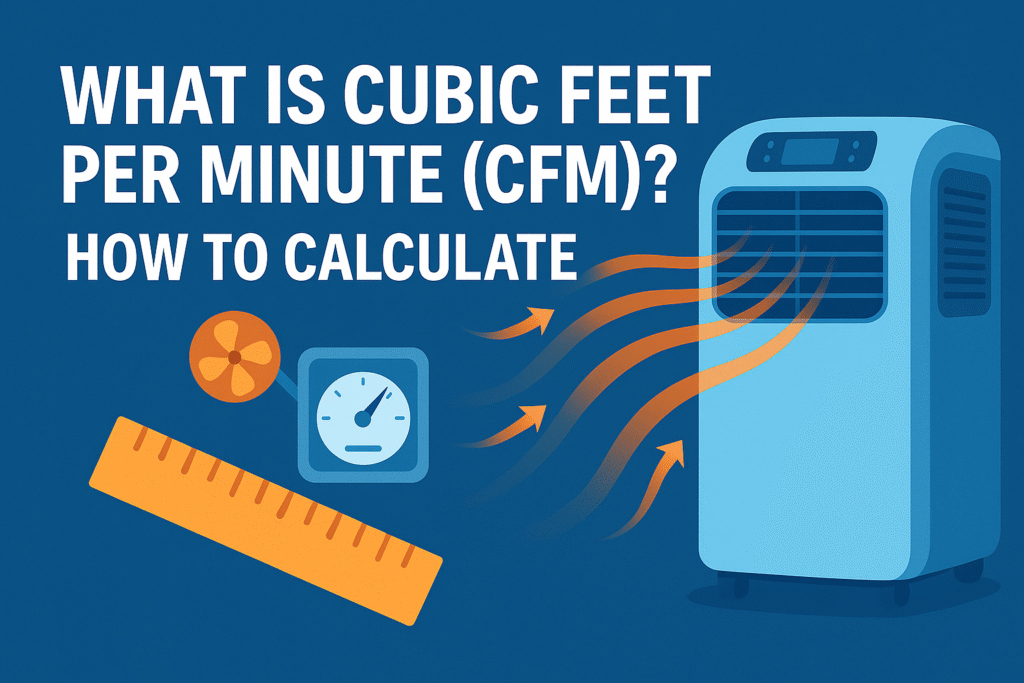If you’re shopping for a new HVAC system or upgrading an old one, you’ve probably come across the term CFM. But what exactly does it mean, and why is it so important?
Whether you’re a homeowner or business owner in Canada, understanding Cubic Feet Per Minute (CFM) is essential to maintaining indoor comfort, improving air quality, and optimizing energy efficiency. In this detailed guide, GM Heating and Cooling Inc. will walk you through everything you need to know about CFM — from what it means to how to calculate it and why it matters in HVAC systems.
What is Cubic Feet Per Minute (CFM)?
CFM stands for Cubic Feet Per Minute — a measurement of airflow. It tells you how much air is moving through a space or system each minute. For example, a fan or HVAC unit rated at 400 CFM moves 400 cubic feet of air every 60 seconds.
This measurement is vital in HVAC design, helping ensure that spaces are heated, cooled, or ventilated evenly. An incorrect CFM can lead to rooms that are too hot, too cold, or stuffy. At GM Heating and Cooling Inc., we use CFM calculations to design systems that are tailored to each unique space, whether residential or commercial.
How to Calculate CFM
To properly size an HVAC system, professionals calculate the required CFM based on the room’s volume and desired air changes per hour (ACH).
CFM Formula:
CFM = (Room Volume in Cubic Feet × ACH) ÷ 60
Step-by-Step Guide:
- Measure the Room Dimensions: Multiply the room’s length × width × height to get its volume in cubic feet.
- Determine the recommended ACH: This varies depending on the room’s use. Bathrooms and kitchens typically need more air changes than bedrooms or living areas.
- Apply the Formula: Use the values in the formula to determine the proper CFM.
Recommended Air Changes Per Hour (ACH):
- Living Room: 4–6 ACH
- Kitchen: 15–20 ACH
- Bathroom: 6–10 ACH
- Bedroom: 5–6 ACH
- Basement: 3–6 ACH
Example: Let’s say you have a bedroom that measures 12 ft × 10 ft × 8 ft, which equals 960 cubic feet. If you want 6 ACH:
CFM = (960 × 6) ÷ 60 = 96 CFM
That means your HVAC system should supply at least 96 CFM to that room to maintain comfortable and healthy airflow.
What Factors Affect CFM Requirements?
Several variables can influence how much airflow your space needs:
- Room Size: Larger rooms need more airflow.
- Ceiling Height: Taller ceilings require more air to be circulated.
- Climate Conditions: In colder climates like Canada, efficient heating airflow becomes more important.
- Room Usage: Kitchens and bathrooms demand more ventilation than bedrooms or hallways.
- Window Type and Insulation: Poor insulation or leaky windows increase airflow demand.
- Ductwork Design: Long or complex duct paths may require higher CFM to maintain efficiency.
GM Heating and Cooling Inc. considers all of these factors during installation to deliver optimal HVAC performance.
Why CFM Matters in HVAC Systems
Correct CFM levels are crucial for ensuring your system works effectively. Here’s why:
- Energy Efficiency: Systems with optimized CFM avoid overworking and help reduce utility bills.
- Temperature Balance: Even airflow prevents hot or cold spots in your home.
- Air Quality: Proper ventilation reduces allergens, humidity, and indoor pollutants.
- System Longevity: Proper airflow reduces stress on system components, leading to fewer repairs and a longer lifespan.
- Noise Levels: Overpowered systems produce more noise; proper CFM ensures quieter operation.
Whether heating your home during a frigid Canadian winter or cooling it during a warm summer, CFM plays a vital role.
Tools for Measuring and Calculating CFM
Understanding and calculating CFM can be complex, but several tools and technologies make it easier:
- Online CFM Calculators: Useful for quick estimates.
- HVAC Load Software: Professionals use tools like Manual J calculations to assess load and airflow needs.
- Anemometers: These handheld devices measure actual airflow coming from vents.
- Flow Hoods: Placed over supply or return vents to measure airflow volume precisely.
GM Heating and Cooling Inc. uses a combination of advanced tools and expert judgment to design systems that perform efficiently and meet your specific needs.
CFM Tips for Homeowners
If you’re a homeowner looking to ensure your HVAC system is running smoothly, here are a few practical tips:
- Schedule a Professional Assessment: Have a certified technician evaluate your HVAC system and airflow.
- Keep Filters Clean: Replace air filters regularly — clogged filters reduce airflow and increase energy consumption.
- Seal and Insulate Ducts: Leaky ducts can cause significant airflow losses.
- Use Smart Thermostats: These help maintain optimal airflow by adjusting fan speeds and run times intelligently.
- Inspect Ductwork Layout: Poorly designed or oversized ducts reduce airflow efficiency.
A well-maintained system is more likely to deliver proper CFM and provide year-round comfort.
Important HVAC Terms Related to CFM
Understanding a few related terms can make CFM easier to grasp:
- Airflow Rate: The volume of air moved by your HVAC system (measured in CFM).
- Ventilation Efficiency: How effectively your HVAC system circulates fresh air.
- HVAC Sizing: Determining the right size system for your space based on BTUs and CFM.
- Static Pressure: The resistance air faces as it moves through ducts. High static pressure can lower CFM.
- Duct Sizing: Proper duct diameter and length ensure optimal airflow delivery.
Knowing how these elements interact can help you troubleshoot airflow issues or speak knowledgeably with your HVAC technician.
Getting Professional Help in Canada
In Canadian climates, where heating needs can be extreme, getting your HVAC airflow right is essential. Partnering with a trusted HVAC provider ensures accurate CFM calculations and properly sized equipment.
GM Heating and Cooling Inc. has extensive experience designing HVAC systems for residential and commercial clients across Canada. From initial assessment to final installation, we make sure your airflow needs are met.
We consider all environmental and structural variables to ensure your comfort and efficiency goals are achieved.
Rebates and Incentives for Energy-Efficient HVAC Systems
If you install an energy-efficient HVAC system with proper CFM calibration, you may qualify for valuable rebates. Across Canada, several programs reward energy-conscious upgrades:
- Federal Green Homes Initiative
- Canada Greener Homes Grant
- Provincial Energy Rebate Programs
- Manufacturer Rebates on High-Efficiency Equipment
GM Heating and Cooling Inc. helps you choose equipment that meets rebate criteria and can assist with the application process.
Final Thoughts
Understanding and calculating your home’s CFM requirement is essential for building a reliable, efficient, and comfortable indoor environment. Whether you’re renovating, building new, or just trying to improve airflow in your home, getting the CFM right is a vital step.
From air quality to energy savings, every part of your HVAC system depends on accurate airflow measurements. That’s why GM Heating and Cooling Inc. takes the time to perform professional assessments, apply proper calculations, and deliver systems that meet or exceed expectations.
If you’re unsure about your current system or are looking to upgrade, reach out to our team. We’re here to guide you through every step — from calculating your CFM needs to helping you find rebates and install high-efficiency solutions tailored to your Canadian home.
Need Help with Your HVAC System?
Contact GM Heating and Cooling Inc. today for expert CFM assessments and airflow optimization. Let’s make your home comfortable, healthy, and energy-efficient — all year round.


